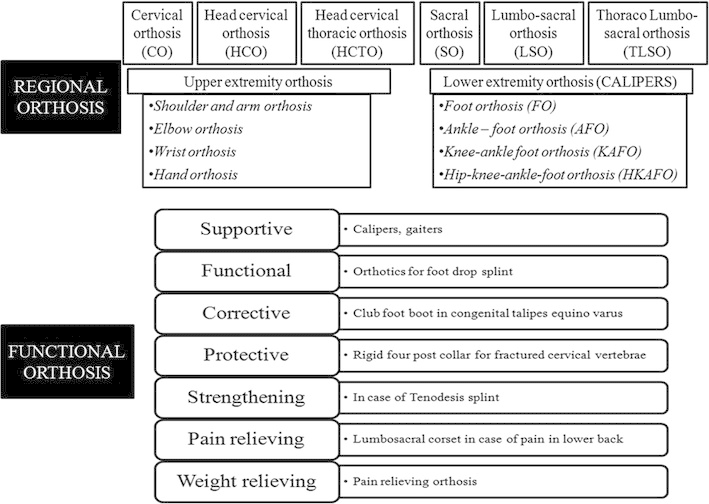Prosthetic/Orthotic Professional Roles. The prosthetic and orthotic workforce includes three distinct roles, two involving clinical care and one non-clinical.
Clinical personnel include:
- Prosthetist/Orthotists,
- Associate Prosthetist/Orthotists.
Non-clinical personnel include:
- Prosthetic/Orthotic Technicians.

Prosthetic/Orthotic Occupational Classification
Prosthetic/orthotic occupations are a spectrum of specialized health care disciplines that combine a unique blend of clinical and technical competencies to provide assistive products for people with physical impairments. In addition to treatment planning and the implementation of custom prosthetic/orthotic interventions, professionals may also be responsible for modular or prefabricated devices, soft goods, mobility aids, postural supports, wheelchairs, and other assistive products related to prosthetic/orthotic services. It is therefore imperative that an appropriate occupational structure is established and maintained to ensure that service recipients receive care from qualified professionals.
The following definitions and descriptions represent the minimum essential knowledge and skills for entry to practice in each occupational classification level.
Individual programmes may exceed the minimum standard without achieving the threshold for the next level of classification.
A Prosthetist/Orthotist is a health care professional who applies the best available evidence to provide clinical assessment, prescription, technical design, and fabrication of prosthetic and/or orthotic devices. Prosthetists/Orthotists work independently and as part of the health professional team. They facilitate treatment plans featuring patient centred goals and establish rehabilitation plans that include prosthetic/orthotic services and monitor outcomes through the application of clinical outcome measures. The profession aims to facilitate service recipients so they have equal opportunities to fully participate in society. The Prosthetist/orthotist is a clinical service provider with all the attributes of an Associate Prosthetist/Orthotist and Prosthetic/Orthotic Technician, but who has completed a higher level of education programme with a scope of practice that includes leadership and training capabilities. These defining elements include: • A broad range of clinical competence, • Exposure to a wide range of technologies, • The ability to integrate the best available evidence, clinical experiences, and critical inquiry and patient goals into decision making, • The ability to supervise or mentor the practice of Associate Professionals and Technicians. Prosthetists/Orthotists are expected to have the highest level of training, decision-making skills, and diversity of competence. Therefore, Prosthetists/Orthotists are expected to act as leaders, mentors, and supervisors for Associate Prosthetists/ Orthotists and Prosthetic/Orthotic Technicians whose entry to practice requires a A more specific list of competencies and a narrower scope of practice.
An Associate Prosthetist/Orthotist is a health care professional who uses evidence-based practice to provide clinical assessment, technical design, fabrication of prosthetic/orthotic devices, and implement the clinical treatment plan. Associate Prosthetists/ Orthotists work as part of the health care team, under the supervision of the Prosthetist/Orthotist. They set goals for use of prosthetic/orthotic devices and deliver services to achieve desired outcomes. This occupation aims to facilitate the service recipients so they have equal opportunities to fully participate in society. Associate Prosthetists/Orthotists possess many of the attributes of a Prosthetic/ Orthotic Technician, in addition to the competencies necessary to provide clinical treatment. In collaboration with other members of the health care team they aim to provide treatment that allows individual users to lead more active and independent lives. This work requires substantial clinical and technical judgment. The principles of biomechanics, pathomechanics, gait analysis, kinesiology, anatomy and physiology are crucial to the ability to provide comprehensive care and a positive clinical outcome. Clinical assessments, treatment, and education are part of the An associate’s responsibilities and require collaborative communication skills. Associate Prosthetists/Orthotists are accountable for working under the supervision and/or mentoring a Prosthetist/Orthotist.
Prosthetic/Orthotic Technicians are non-clinical service providers who support the technical design of prosthetic/orthotic devices and are competent in prosthetic/ orthotic device fabrication. Prosthetic/Orthotic Technicians work as part of the health care team. This occupation aims to support the clinical staff in enabling the service recipients so they have equal opportunities to fully participate in society. Prosthetic/Orthotic Technicians are experts in device fabrication. They possess knowledge of material science, engineering principles, technical procedures/ processes, and safe practice related to prosthetics/orthotics. This classification has no clinical contact with users. They may work directly with users to resolve technical issues, but they do not participate in clinical aspects such as fitting adjustments, static or dynamic alignment. Prosthetic/Orthotic Technicians are accountable for work within their scope of practice under the supervision of a Prosthetist/Orthotist and/or an Associate Prosthetist/Orthotist.
